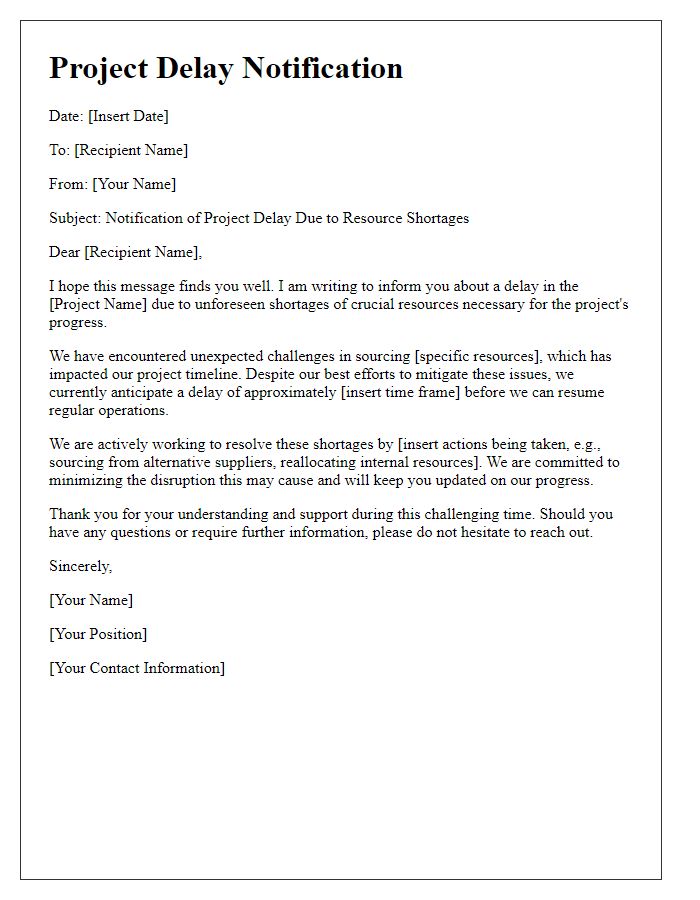Hey there! If you've ever faced a delay in a project, you know how tricky it can be to communicate that news effectively. It's not just about stating the facts; you want to convey understanding and maintain trust with your stakeholders. Crafting the right letter can make all the difference in managing expectations and keeping everyone on the same page. So, let's dive into some key tips and a handy template to help you navigate project delay notifications smoothly!

Clear Communication and Specificity
Project delays can significantly impact timelines and stakeholder expectations. Effective communication regarding such delays is crucial. For instance, when a construction project in Denver, Colorado, encounters delays due to unforeseen weather conditions (such as heavy snowfall in January 2023), it is essential to inform all parties promptly. Specific details about the new projected completion date, mitigation strategies to address the delay, and potential impacts on budget (such as additional labor costs due to extended time) reinforce clarity. Transparency regarding the causes of delay, such as supply chain disruptions affecting materials (like drywall and lumber), helps maintain trust among stakeholders. Regular updates throughout the process ensure all parties remain informed, ultimately fostering collaboration and understanding.
Apology and Empathy
Project delays can impact timelines and budget allocations. Unexpected circumstances, such as resource shortages or technical difficulties, lead to setbacks in project deadlines. Timely communication about these setbacks is essential to maintain transparency with stakeholders. Expressing sincere apologies reflects an understanding of potential inconvenience caused. Acknowledging the emotional and financial implications for all parties fosters an empathetic atmosphere. Highlighting steps taken to mitigate delays reassures stakeholders of commitment to project goals. Providing revised timelines ensures clarity and sets realistic expectations moving forward.
Detailed Reason for Delay
A project delay can arise from unexpected circumstances, such as supply chain disruptions. For instance, shortages of essential materials like steel or semiconductor chips can halt progress on construction or manufacturing. Unforeseen weather events, such as hurricanes or snowstorms, can further impede timelines, especially in outdoor projects. Additionally, labor shortages due to health crises or strikes can slow down workforce availability, affecting the completion of critical milestones. Technical challenges may also emerge, including software glitches or equipment failures, which require additional time to resolve. Communication breakdowns between stakeholders can exacerbate these issues, leading to misunderstandings and further delays in project workflows.
Updated Timeline and Next Steps
A project delay notification is critical for maintaining transparency between stakeholders regarding project timelines. The delay may be attributed to unforeseen circumstances, such as supply chain disruptions impacting materials, specifically high-demand components like semiconductors, which have been particularly affected since 2020. Stakeholders should be informed that the updated timeline reflects adjustments made after careful evaluation of current resource availability and team capacity. The new completion date is projected for Q1 2024, which allows for thorough quality assurance and testing phases to ensure project success. Next steps include scheduling a team meeting to discuss strategies for efficient workflow management and identifying potential risks that may arise as work resumes.
Contact Information for Further Queries
Project delays often arise due to unforeseen circumstances such as supply chain disruptions, resource availability issues, or unexpected technical challenges. Stakeholders must be informed promptly to manage expectations effectively. Key contact information includes project manager details, such as name, email, and phone number for direct communication. Additionally, including the date of notification ensures transparency regarding the timeline. Providing an updated project schedule highlights revised milestones and deliverables. Clear communication channels facilitate better understanding and collaboration among all parties involved, allowing for focused problem-solving and adjustments to project plans.
Letter Template For Project Delay Notification Samples
Letter template of project delay notification addressing funding issues.

Letter template of project delay notification due to resource shortages.

Letter template of project delay notification citing unforeseen circumstances.

Letter template of project delay notification emphasizing commitment to quality.










Comments